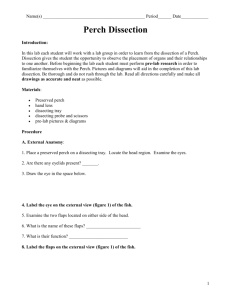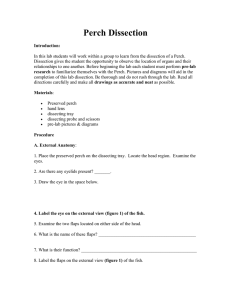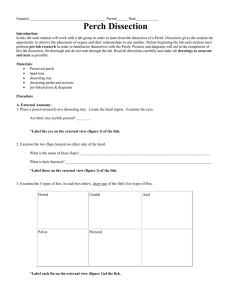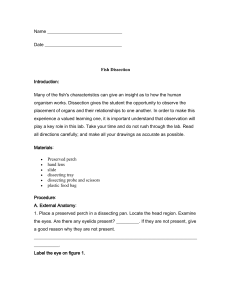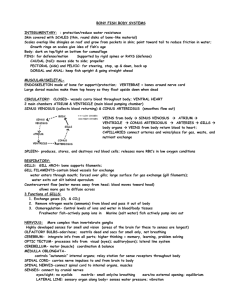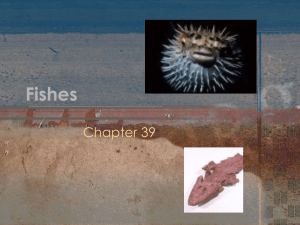10. Perch Dissection Lab
advertisement
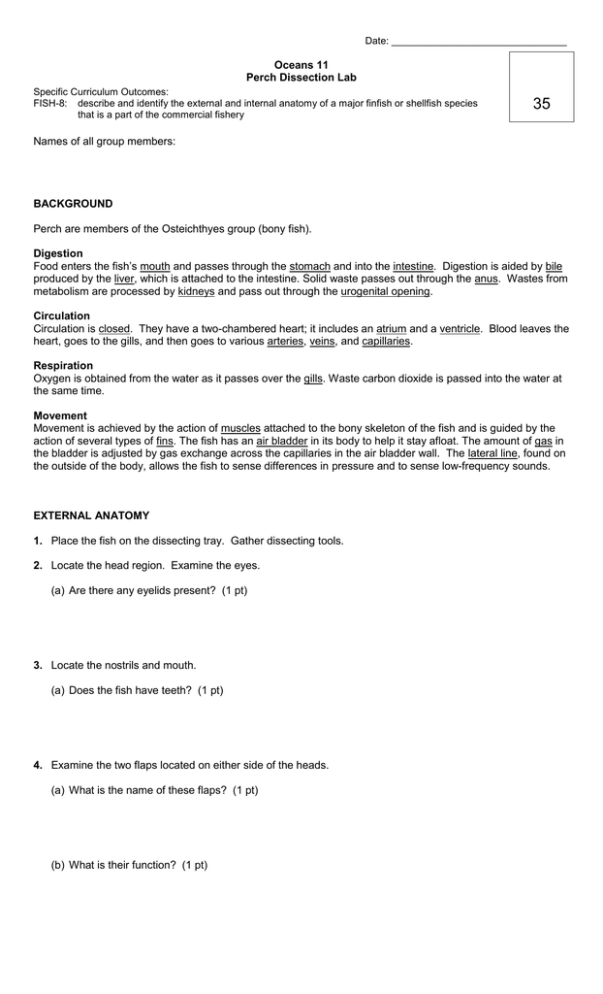
Date: ________________________________ Oceans 11 Perch Dissection Lab Specific Curriculum Outcomes: FISH-8: describe and identify the external and internal anatomy of a major finfish or shellfish species that is a part of the commercial fishery 35 Names of all group members: BACKGROUND Perch are members of the Osteichthyes group (bony fish). Digestion Food enters the fish’s mouth and passes through the stomach and into the intestine. Digestion is aided by bile produced by the liver, which is attached to the intestine. Solid waste passes out through the anus. Wastes from metabolism are processed by kidneys and pass out through the urogenital opening. Circulation Circulation is closed. They have a two-chambered heart; it includes an atrium and a ventricle. Blood leaves the heart, goes to the gills, and then goes to various arteries, veins, and capillaries. Respiration Oxygen is obtained from the water as it passes over the gills. Waste carbon dioxide is passed into the water at the same time. Movement Movement is achieved by the action of muscles attached to the bony skeleton of the fish and is guided by the action of several types of fins. The fish has an air bladder in its body to help it stay afloat. The amount of gas in the bladder is adjusted by gas exchange across the capillaries in the air bladder wall. The lateral line, found on the outside of the body, allows the fish to sense differences in pressure and to sense low-frequency sounds. EXTERNAL ANATOMY 1. Place the fish on the dissecting tray. Gather dissecting tools. 2. Locate the head region. Examine the eyes. (a) Are there any eyelids present? (1 pt) 3. Locate the nostrils and mouth. (a) Does the fish have teeth? (1 pt) 4. Examine the two flaps located on either side of the heads. (a) What is the name of these flaps? (1 pt) (b) What is their function? (1 pt) Date: ________________________________ 5. Examine the five types of fins. (a) How many fins does the fish have? Complete the chart for each type. (5 pts) Dorsal Caudal Anal Pelvic Pectoral (b) What is the purpose of each of the fins? Complete the chart. (5 pts) Dorsal Caudal Anal Pelvic Pectoral 6. Locate the lateral line. 7. Use tweezers to remove a scale from the fish. Observe the scale. 8. Now go to the microscope and observe the pre-made slide of a scale. (a) Draw a sketch of the scale. (1 pt) (b) Is the scale cteniod or cycloid? (1 pt) 9. Label the diagram of the external anatomy of the fish. (10 pts) INTERNAL ANATOMY Gills 1. Using your thumb, lift up the edge of the operculum and raise it up as far as you can. Using scissors, cut the operculum off as close to the eye as possible. You have exposed the gills. The gills are layered one on top of another. Using your probe, carefully lift each of these layers. (a) How many layers did you find? (1 pt) 2. Remove one of the layers and examine the feathery structure. Date: ________________________________ Internal Organs Cutting Diagram Anatomy Diagram 3. To expose the internal organs, you will cut away parts of the muscular wall. Refer to the cutting diagram above. 4. Use the probe to locate and observe the following internal organs. Check off each one you see. - air (swim) bladder stomach intestine liver kidneys - gonads (ovaries or testes) heart (atrium and ventricles) muscles ribs vertebrae (backbone) LAB QUESTIONS 1. What is the function of the air bladder? (1 pt) 2. What gonad was visible? Describe its appearance. (2 pts) 3. Do perch have an open or closed circulatory system? What does this mean? (2 pts) 4. Describe what the muscles look like. (1 pt) 5. What adaptations for life in the water did you observe in the perch? Describe what the adaptation does for the fish. (2 pts)

